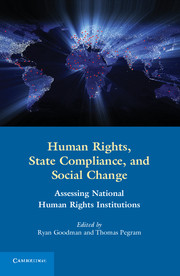1 - Introduction
National Human Rights Institutions, State Conformity, and Social Change
Published online by Cambridge University Press: 05 June 2012
Summary
Introduction
Over the past twenty years national human rights commissions and human rights ombudsmen have emerged in every continent and subregion of the world, and in dozens of democratic and dozens of undemocratic states alike. This institutional innovation – a “national human rights institution” (NHRI) in UN parlance – is broadly defined as “a body which is established by a government under the constitution, or by law or decree, the functions of which are specifically designed in terms of the promotion and protection of human rights.” Accounts of the number of NHRIs now in existence vary from around 120 to 178, established in approximately 130 countries. By conservative measures, since 1990 the population of NHRIs has witnessed a staggering fifteen-fold increase (at the rate of over five new institutions established per year).
The proliferation of NHRIs is part of a broader trend driven by international actors that promote the diffusion of legal and institutional innovations across national boundaries. Beyond the question of why governments create NHRIs, this volume builds on existing scholarship by inquiring into why NHRIs matter, how they operate in practice, and, crucially, under what conditions they can effectuate compliance with human rights standards and bring about social change.
- Type
- Chapter
- Information
- Human Rights, State Compliance, and Social ChangeAssessing National Human Rights Institutions, pp. 1 - 26Publisher: Cambridge University PressPrint publication year: 2011
References
- 2
- Cited by



